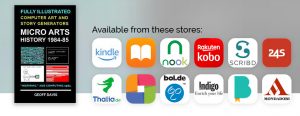Top reviews for Micro Arts
“This is genuinely awesome, it’s fascinating and I’m sure [Creative Computing] students will find it engaging.”
Professor Mick Grierson, Creative Computing Institute, University of the Arts London (CCI UAL), November 2020
talking about Micro Arts inclusion in the exciting new Computer Arts Archive from CAS and BCS UK.
“Micro Arts has produced some stunningly original work.”
Review, Personal Computer World 1985
“The computer art that we have come to take for granted is only one aspect of a subject that is as old as computers themselves.”
Acorn User 1987
“I think this period is something of a lost era in digital art. It’s definitely a good idea to be engaging with it.”
Sean Clark, Computer Arts Society, Fellow BCS 2019. Visit Sean Clark’s website
“Things move fast in the computer world, don’t they? The most successful [Micro Arts programs] are the animated designs, hypnotic and colourful collages that offer mobile abstracts… All colour schemes can be adapted, and, if you wish, the program itself can be interfered with (that’s the interactive part).”
Review, Blitz Magazine 1985
“Looks fascinating! I love the imagery too.”
Brian McClave, Site Eye 2019
“The alternative society is still throbbing at Micro Arts.”
Sinclair User February 1985
Review of MA2: Various Unusual Events, Sinclair User February 1985
“Gremlin [reviewer] was delighted to receive a large scroll through the post the other day entitled Cow Boils Head. The unusual missive tells the story of a cow which forced a man to boil his head in a bucket. Veteran Gremlin fans will immediately recognise the delicate touch of Geoff Davis and Micro Arts, who have devised a program which churns out endless variations on the tale.”
Review of MA4: Cow Boils Head, Sinclair User, Gremlin gossip, September 1985
“The display mixes colour, shape and timing, and it’s different each time you run it. Definitely to ‘enhance your next dinner or cocktail party, union meeting or conference!’
Pass the Pina Colada, comrade.”
Review of MA1: Geoff Davis ‘Abstract Originals’, Computer News 1985
“Inspiring. A very promising start from Micro Arts. All worth thinking about and testing for yourself.”
Review of MA3: Martin Rootes Vol. 1, A&B Computing February 1985
Get the new Micro Arts ebook – universal link
Full reviews
These quotes are from some of the reviews in the consumer and professional computer press (for scans see later). Some of the reviewers were enthused by computer art, others baffled or offended, often simultaneously, just like now. Only a few reviews have survived as photocopies. Most magazines have disappeared and the companies absorbed into larger media companies. The art software was available as mail order data cassettes, advertised in the computer press. There were three Micro Arts computer art data cassettes:
MA1: ‘Abstract Originals’ – Geoff Davis (5 segued generative art programs)
MA2: Various Unusual Events – Geoff Davis (6 examples – code art, a SCUM Manifest animation, generative graphics etc.)
MA3: Vol 1. – Martin Rootes (animated art programs, based on Muybridge, Duchamp etc.)
MA4: Cow Boils Head – Geoff Davis (text story generator). Not on cassette, as telesoftware (Prestel Micronet)
REVIEWS
Blitz Magazine Review, February 1985 (see Facebook page)
Things move fast in the computer world, don’t they? A new organisation, Micro Arts, claims modestly to be pioneering in this field with a set of programs which can be altered or adapted to suit your mood or your wallpaper. According to founder Geoff Davis, “Micro Arts resides in a sort of sideways area from the rest of the art world. The computer world think the programs are too weird and not technical enough, and the art world think they’re too technical.”
The idea behind MA is to encourage the development of computer art in general with a range of software and video show-reels. Of the three programs available the most successful are the animated designs, hypnotic and colourful collages that offer mobile abstracts very much in the style of Mondrian and Pollock. All colour schemes can be adapted, and, if you wish, the program itself can be interfered with (that’s the interactive part).
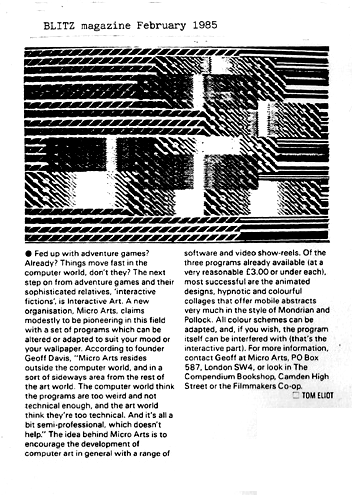
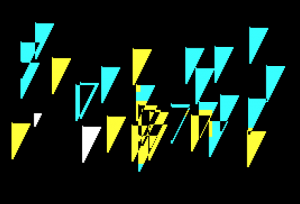
Personal Computer World [1] Review, 1985 – Chris Bourne (extracts)
Micro Arts has produced some stunningly original work.
When a bunch of characters whom most of us might regard as terminal avant-gardists, or terminally nuts, or both, start talking about computer art, and produce programs to write stories and draw pictures, with frequently weird results, the notoriously invisible ‘man in the street’ is apt to dismiss the lot.
Micro Arts is an organisation dedicated to exploring concepts of art on home computer systems such as the Spectrum or BBC [Micro]. Geoff Davis started Micro Arts. He’s a writer of fiction and has a particular interest in using micros to generate language. Simon Holland is an ex-art student currently working as a film editor for the BBC, and Bruno de Florence is a French film-maker contributing to Micronet 800, where subscribers will shortly be able to find 200 pages of Micro Arts articles, information and software.
Sinclair User Review, Gremlin gossip, January 1985
We cannot imagine Sir Clive [Sinclair] relaxing in his Jacuzzi without some form of mental stimulation. He might enjoy reading the first issue of Micro Arts magazine. The forward of this extremely pretentious magazine was penned by one Clive Sinclair, and contains a lyrical exposition of the therapeutic qualities of hacking.
“It is the Computer personality who dares face change without feeling the sense of loss that goes with the departure from the womb” rambles ‘Clive’. We know he wants to abolish doctors and schoolteachers in favour of computers, but the Spectrum as a substitute for motherhood?
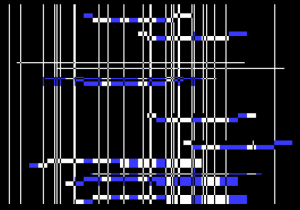
Sinclair User Review, Gremlin gossip, February 1985
The alternative society is still throbbing at Micro Arts, the magazine Gremlin discovered in January. The high priests of pretension have now released ‘Micro Arts 2, Various Unusual Events’, a selection of programs on cassette. The events include ‘Minimal’ which fills up the screen very, very slowly. ‘Dada’ makes up words at random. Pride of place goes to ‘The Money-Work System’ based on The Scum Manifesto by Valerie Solanas. Gremlin regards this as essential viewing for all non-patriarchal non-feeling fascists, ie men, especially ones who cannot win at Hampstead [real estate game]. Buy the program and learn why only “very young or very sick women” will endure male company without being “coerced or bribed”.This is now online at
https://sinclairuser.com/035/gremlin.htm
Computer Weekly Review, August 30, 1984
Try imaging a monthly magazine devoted to shattering the popular image of computer personal as, well, dull. That may sound alright, but suppose the same magazine then portrayed its subject as glamorous and zany painters of the monochrome screen? Being propelled to the opposite extreme sounds like a lot of hard work. This is how the publishers of the new magazine Micro Arts view average computer buffs – I beg your pardon, “computer personalities”. I bet you never knew there was so much in it.
Commodore Computing International Review, Vol 3 issue 9 April 1985
Computer art has come a long way since its ‘Mickey Mouse’ origins. Geoffrey Davis, editor of computer arts magazine Micro Arts, traces the roots of computer art and suggests that the graphic capabilities of the micro have yet to be fully explored. (This article is lost.)
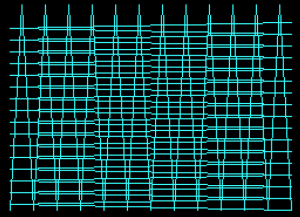
Review: ACORN USER December 1987
PRETTY AS A PICTURE by Brian Larkman
Computer artist Karl Torokhas found stunning graphics are possible if you turn the technology to your advantage. We all know what computer art is – we see it every time we watch the television. Yet the computer art that we have come to take for granted is only one aspect of a subject that is as old as computers themselves. Computer art is separate from computer graphics in the same way that fine art painting is separate from graphic design or illustration. Both disciplines use many of the same techniques but ‘art’ somehow carries the impression of loftier ideals and less interest in the commercial market. A range of techniques are available for the computer artist to produce screen images. These include simple paintbox systems, more complex painting hardware, such as that by Quantel, digitising or frame-grabbing and programmed imagery.
This can be carefully designed, as with TV station identification trailers for example, or art generated by the computer with random elements, a style used by the Micro-Arts group. All of these systems are fine if the screen display is the final destination for the image – some artists even value its temporary nature.
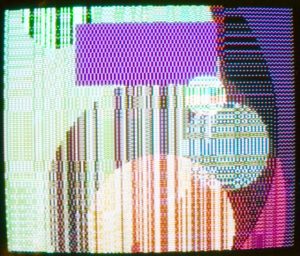
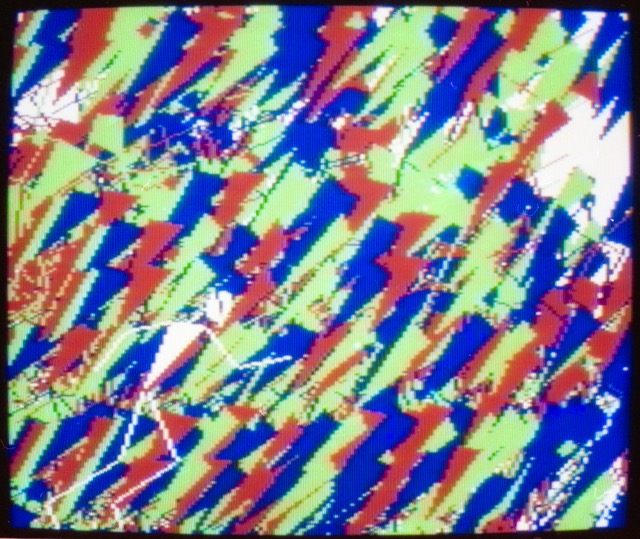
PCW 1985 general review article – second page lost:
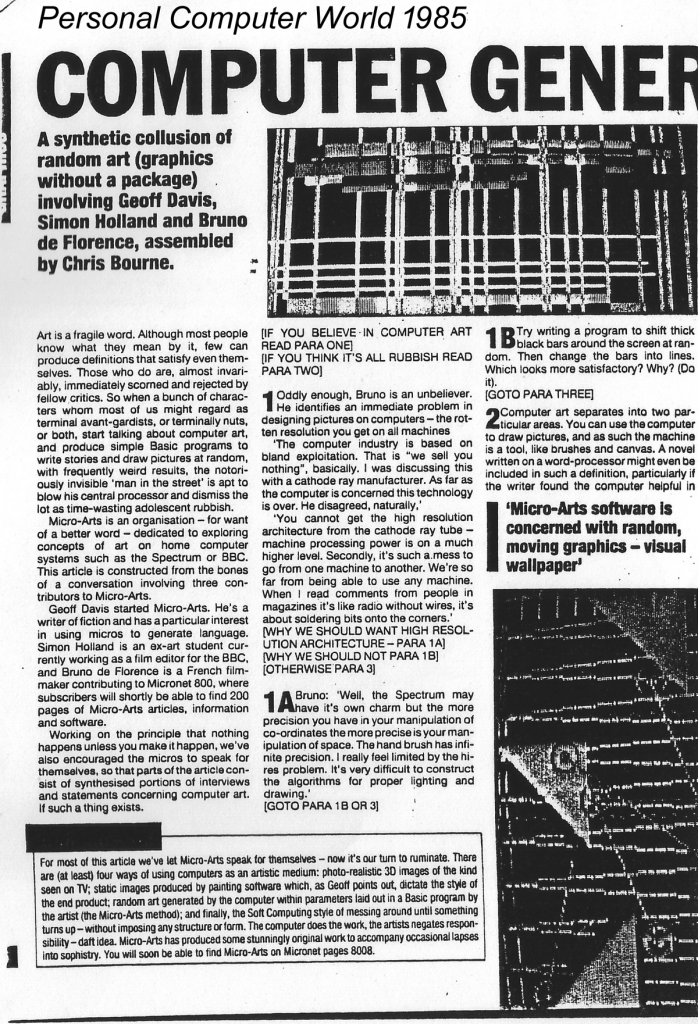
DATA CASSETTE REVIEWS
(see also Sinclair User, February 1985, above)
These are specific art piece (the MA series) reviews. In 1984 public software was distributed on audio data cassettes, which had an audio conversion of the data bits recorded on them. This audio was converted back into data bits by being played into the computer using a standard audio lead, where a converter and error correcting software would figure it all out. The sound of this is the noisy crackling which some people might recall from the old dial-up modems.
Data cartridges also existed but had a big overhead for production so cassettes were cheaper. The Spectrum and BBC Micro did not use cartridges, and this is one reason why Micro Arts released only for the Spectrum and BBC Micro. Micro Arts cassettes had black and white designs on the cover. They were advertised in the computer press, and were posted through the Royal Mail as far afield as Australia. In 1985 the software could also be downloaded on Prestel Teletext.
Computer News Review, 1985
MA1: Geoff Davis – “Abstract Originals” – definitely to “enhance your next dinner or cocktail party, union meeting or conference!” Clearly aiming at a wide market, the display mixes colour, shape and timing, and it’s different each time you run it. Pass the Pina Colada, comrade.
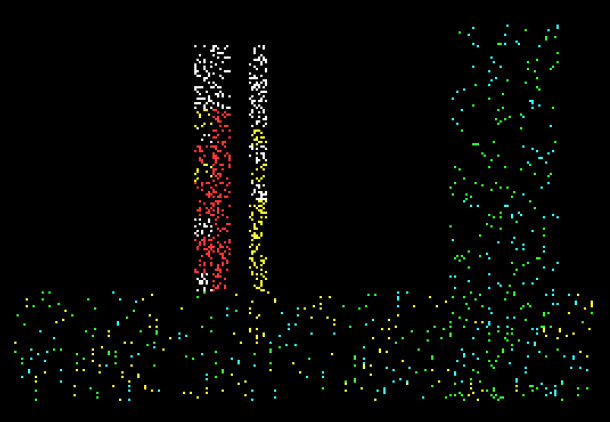
MA2: Geoff Davis – Unusual Events is riddled with that peculiar English art college humour. I chose “Minimal – the longest shortest program”. At first a white point appeared at the bottom of the screen. Then nothing. I waited and waited, until eventually discovering that the whole screen was meant to be filled with points (45,056 of them) but that in between each point you had to wait twenty minutes.
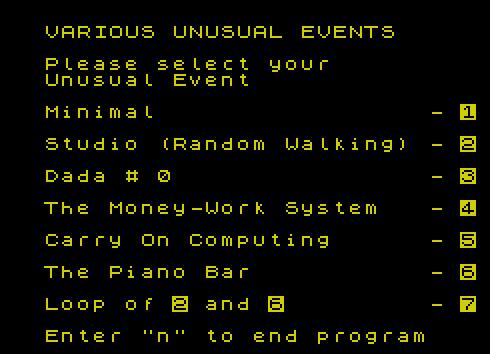
Review: A&B Computing February 1985 (see Acorn Computing A&B archive)
MA3: Martin Rootes–Vol. 1
A very promising start from Micro Arts. Graphics are one of the key areas in home computing and they can be quite inspiring on the BBC. Try this package for size. Can the computer produce great works of art? Is it just a tool for the human artist? All worth thinking about and testing for yourself. MA3 helped to remind me that the BBC Micro can be fun as well as very useful.
Ratings: Graphics 100%; Value for Money: 80%
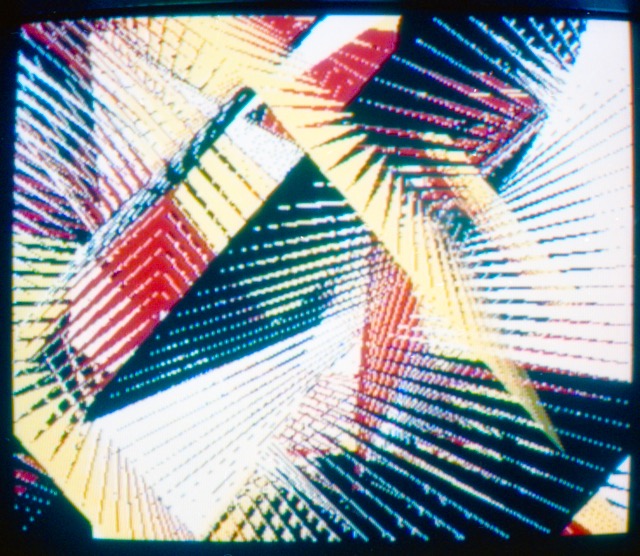
MA4: Geoff Davis –Cow Boils Head (Prestel only, 1985)
Review: Sinclair User, Gremlin gossip, September 1985
Gremlin was delighted to receive a large scroll through the post the other day entitled Cow Boils Head. The unusual missive tells the story of a cow which forced a woman to boil her head in a bucket.
Veteran Gremlin fans will immediately recognise the delicate touch of Geoff Davis and Micro-Arts, who have devised a program which churns out endless variations on the tale. Micronetters may soon be compelled to stomach it, as the high priests of pretension have taken 200 teletext pages to purvey their manic drivel.
“We don’t want to totally freak people out at first,” says the suspiciously mild-voiced Geoff.
Note: MA4 is a story generator which selects from banks of words linked syntactically to a short story ‘Cow Boils Head’. Shown in exhibitions, but did not get a formal software release. It was on Prestel teletext in late 1985.
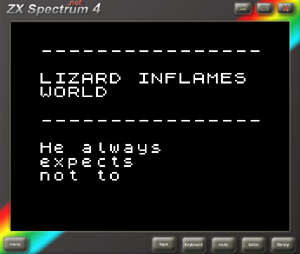
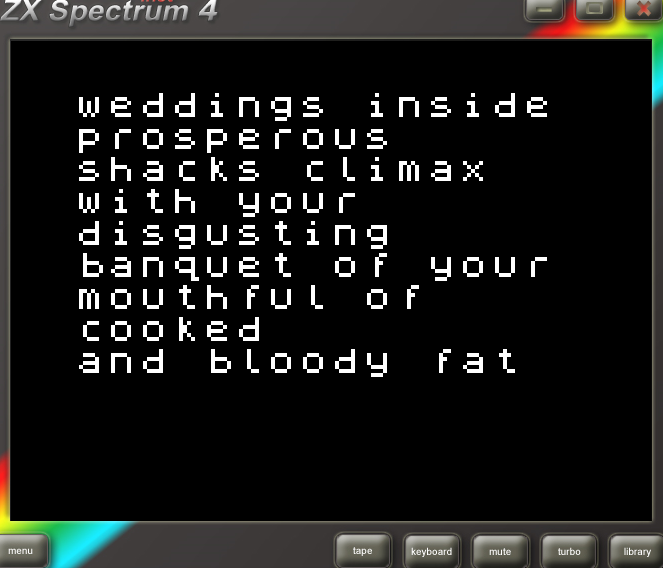
Above: MA4 Cow Boils Head software story generation
-
PCW ended in 2019 and was bought by Incisive Media ↑
Approval progress comment Mar 2019
The major magazines still running are Computing (owned by Incisive Media) and Computer Weekly (now online, owned by TechTarget). Others such as Acorn User were bought by IDG Media. Sinclair User, part of Emap, was absorbed by Ascential. See below for my attempts to get approval. As they approve copyright, I’ll post the reviews, they have until 29/2/2019 to reply, then I’m putting them on here, and the actual book can come out.
The National Museum of Computing, Bletchley Park UK have been very helpful. I’ll do a proper page on them soon. They said:
“Normal academic practice is to “make best efforts” to seek permission from the copyright owner (eg. publisher, author, or photographer). My practice is to send the copyright owner an email request. It is very unusual in my experience for permission to be withheld. […]
If the copyright owner is not known or I get no response to an email then it is my practice it to go ahead. I don’t think an author should ever be inhibited from publishing because copyright ownership cannot be ascertained, but the “best efforts” protocol is a wise precaution and prevents reputational damage to the academic community.”
Blitz magazine is now on Facebook, and they have approved publication, as has Dave at A&B Computing, which is now in an Acorn Computing archive with an active forum. All the others didn’t reply, which is hardly surprising for 40 year old reviews of my old software.
February 2019
Advice from:
National Computer Museum
Bletchley Park UK
Documentation and History of micro computers
Normal academic practice is to “make best efforts” to seek permission from the copyright owner (eg. publisher, author, or photographer). My practice is to send the copyright owner an email request. It is very unusual in my experience for permission to be withheld. However, publishers like Time-Life will try to exact very high fees. If the copyright owner is not known or I get no response to an email then it is my practice it to go ahead. I don’t think an author should ever be inhibited from publishing because copyright ownership cannot be ascertained, but the “best efforts” protocol is a wise precaution and prevents reputational damage to the academic community.
Martin
—
Computing – long serving magazine
https://www.computing.co.uk/static/about-us
Dear Alan
I am writing a short book on the history of a computer art software company ‘Micro Arts’ 1984-1985. Some of the graphics and art programs were reviewed in Computing in Feb 1985. It ended up on Prestel, Micronet 800, with downloadable telesoftware.
I am checking that you would allow me to reprint this review in the book. I can send the review by email if you need to see it.
I am not sure Publishing is the right department, please forward if appropriate.
Regards
Geoff Davis
—
Dear Dave A&B Computing
I am writing a short book on the history of a computer art software company ‘Micro Arts’. Some of the programs for the BBC Micro were reviewed in A&B Computing in Feb 1985, which I think you archived, your email was on the DVD page, there are no contact details.
I am checking that you would allow me to reprint this review in the book. I can send the review by email if you need to see it.
I had the original review print, I did not get it from the archive.
Regards Geoff Davis
—
Commodore Computing International
“Nick Hampshire Publications”
No contact details
Archive.org only
CROFTWARD LIMITED went bust in 1989
—
Acorn User
Bought by IDG Media
PARIS BUREAU
idgnews@idg.com
Peter Sayer – Paris Bureau Chief
Dear Peter
I am writing a short book on the history of a computer art software company ‘Micro Arts’. Some of the programs for the BBC Micro were reviewed in Acorn User in 1984-85, which was acquired by IDG Media.
I am checking that you would allow me to reprint this review in the book. I can send the review by email if you need to see it.
Incidentally, several French people wrote and contributed to the project, which was a computer art forum with software. It ended up on Micronet (like Minitel). They have also contributed to the new book.
Regards
Geoff Davis
—
Computer Weekly is now free and online
Online form 20/2/2019
Dear Computer Weekly
I am writing a short book on the history of a computer art software company ‘Micro Arts’. Some of the programs were reviewed in CW in 1984-85.
I am checking that you would allow me to reprint this review in the book. I can send the review by email if you need to see it.
Regards
Geoff Davis
—
Sinclair User – Emap now
info@ascential.com
Dear Ascential
I am writing a short book on the history of a computer art software company ‘Micro Arts’. Some of the programs were reviewed in 1984-85. Sinclair User was part of EMAP.
I am checking that you would allow me to reprint this review in the book. I can send the review by email if you need to see it.
Regards
Geoff Davis
sent email 20/2/2019
—
Personal Computer Weekly – Incisive Media
csqueries@incisivemedia.com
Sent email from mag 20/2/2019

